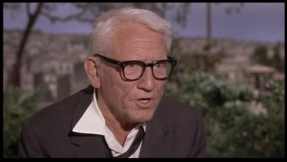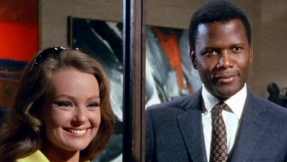White Patriarchal Fate Determiners in “Guess Who’s Coming To Dinner” and “Death Proof”

Upon discovering that his white daughter is adamantly convinced of marrying her African American lover, Matt Drayton, the established patriarch of the San Franciscan family, states that, in regards to whether or not he will condone the marriage, “If you are expecting a sensible statement, you will have to give me time.” Likewise, albeit for substantially different reasons, the female figures being hunted by Stuntman Mike are in desperate need of time in order to escape their killer. Time, however, is of limited quantity. Guess Who’s Coming To Dinner and Death Proof both illustrate white patriarchal figures who, over the course of the films, act as fate determiners for the wide range of black characters. It is only through the allowance and passage of time — and the subsequent changing characteristics of the black characters mainly concerning their sexualization — that the role reversal process between the two races is able to be obtained, ultimately allowing the once disenfranchised black characters to disempower the white patriarchal figure.

The two white patriarchs of Guess Who’s Coming To Dinner and Death Proof, Matt Drayton and Stuntman Mike, respectively, are immediately established as the leading authorial destiny controllers from the onset of the films. Joey’s engagement with Dr. Prentice shocks the three other female characters present — Catherine might “faint because he’s a negro,” Tillie claims that “all hell’s done broke loose,” and Hilary is left utterly speechless — yet their worries towards the fast approaching marriage are heavily diluted due to the overwhelming importance of Matt’s opinion towards the topic. Indeed, any other opinion besides Matt’s is quickly brushed aside as diminutive in comparison, as noticed by Catherine’s consistent worrying of his reactions. Matt’s position as the fate determiner of the black character, Dr. Prentice, is solidified when the latter overtly decrees that the marriage will not take place without the distinct approval of both of Joey’s parents. Yet, because of the patriarchal structure of the family, this need of approval shifts directly towards Matt, and therefore enabling him to hold the destiny of the African American character in his hands. Stuntman Mike is, similarly, seen as the fate determiner of the three women presented in the first half of Death Proof. With the camera positioned at the front of his speeding “death-proof” car, Stuntman Mike is truly a personified fate, a being that is chasing after his victims, as if they were targets, looking to end their lives, thus acting as the ultimate fate controller. The three female characters are, like those in Guess Who’s Coming To Dinner, relatively weak in comparison to the patriarchal male figure; their disempowerment stems from their overly sexualized and childish characteristics, and is further emphasized by the repetitive images of their naked feet. Therefore, like Dr. Prentice, the black character’s fate, in this case Julia, is determinable by the white character.

The ability of the white patriarchal figures to enforce disenfranchisement upon the African American characters is produced directly from the characterization that the latter receive. Dr. Prentice is seen as predominately feminine in nature, a trait that is illustrated through a variety of his characteristics. Instead of housing masculine features that might enable him to enforce his authority upon the patriarchal father, he is, rather, depicted as a male character who has, in a way, swapped the traditional gender roles with this soon-to-be wife. Indeed, this is noticed not only through his posture — sitting crossed legged as opposed to the more “masculine” stance — but also through his seemingly innate lack of sexuality and inability to establish any sort of control over the situations at hand. Dr. Prentice’s ideas of not wanting Joey to somehow become hurt through their participating in miscegenation only reinforces Matt’s white, patriarchal control over the couple, as this ultimately reduces his masculine strength. While Dr. Prentice can easily stand up to his own father, who, like Tillie, is “just as black as he is,” his feminine desexualization allows Matt to continue residing in his fate-controlling status. Reversely, Julia’s intense over sexualization allows her to, likewise, become completely subjected to Stuntman Mike’s life controlling influences. If Dr. Prentice and Julia represent a dichotomic binary of sexuality, then Julia would certainly be on the top of the scale. Just as Dr. Prentice appears to be innately lacking these characteristics, Julia appears to flourish on them. Not only does she constantly talk about erotic activities and dance in highly controversial manners, she even coerces her otherwise averagely sexualized friends into becoming more sexualized.
These highly opposed characteristics of the African American characters directly contribute to their fates at the hands of the white patriarchs. The feminine and desexualized Dr. Prentice’s destiny, that of an approved marriage, lies in the hands of Matt, who, furthermore, appears to determine the entire sexuality of the black character — the act of miscegenation (sex between two different races) between Dr. Prentice and his wife must be approved and given over by the white patriarch. The similarly feminine but highly sexualized Julia suffers death at the hands of the fate controlling Stuntman Mike. Yet, while the white patriarch depicted as Matt must allow Dr. Prentice to experience these feelings, Stuntman Mike delivers Julia an act of forced miscegenation, ramming his car into hers, splitting her up the middle, and subsequently killing her. Both African American characters pay for their dichotomic characteristics in different ways, but both are ultimately disempowered.

The previously established concept of time in relation to the two films can now be examined as an agent in the shifting power dynamics that the second part of Death Proof presents. While all three parts of the two films represent only the small amount of time within a singular day, the time needed for Dr. Prentice and Julia to gain authority over the white patriarchal figure is finally realized through the 14 month gap which divides the two distinct parts of Death Proof. The resulting African American characters strongly illustrate this shifting power dynamic between the races. Abernathy and Kim depict a combination between the characters of Dr. Prentice and Julia — the desexualized and the hyper sexualized — and this is illuminated through various filmic techniques and their own characterizations. The opening scenes from part two, filmed in black and white, symbolizes the “old” portrayal as shown in not only Guess Who’s Coming To Dinner but also the first section of Death Proof. Indeed, Abernathy’s placement in the car, her bare feet exposed out the window, is the exact same as Julia’s, thus insinuating that these African American characters will, once again, be manipulated by the fate controlling white patriarchal figure. However, this idea is immediately dashed and the correct interpretation rectified as she exits the car, sits on it in a masculine stance — as opposed to the feminine Dr. Prentice — and places her shoes on, dispelling any means of vulnerability. Likewise, the black and white style soon fades, thus ushering in and establishing a new quality of African American character. Abernathy and Kim both become more characterized by their masculine qualities, differing greatly from the portrayal of Julia. Yet, their sense of sexuality has not been completely extinguished. Instead, there is a mixture of both, with the extended gap of time producing individuals who are not ashamed to be sexualized, but do not foster it as their only form of characterization.

The allowance of time engenders the climatic shift of power that is represented between the white and black characters, enabling Abernathy and Kim to disempower the white patriarchal figure through the same means in which that figure disenfranchised the black characters of Dr. Prentice and Julia. Certainly, the two black characters at the end of Death Proof, individuals who are a combination of the masculine and the feminine, the desexualized and the hyper-sexualized, are able to switch places with both Matt Drayton and Stuntman Mike, brutally enforcing symbolic miscegenation onto the white patriarchal figure through yet another highly erotic car-chase scene. Abernathy and Kim lack the need of approval of miscegenation brought forth by the white male as Dr. Prentice did and they lack the weakness to be the victim of forced miscegenation as Julia was. Conversely, the black characters are able to disrupt the power dynamics of the two races, killing Stuntman Mike by acts of forced miscegenation, illustrating that, through the passage of time, they are able to disempower the disenfranchiser, thus enacting a new role as fate determiners over the once fate controlling white patriarch.
Guess Who’s Coming To Dinner and Death Proof produce a type of linear storyline that illustrates a distinct progression of African American characters. The transformation from the feminine, desexualized Dr. Prentice and the similarly feminine but hyper sexualized Julia to the androgynously and confidently sexualized Abernathy and Kim not only disempowers the white patriarchal figure, but also produces black characters who house both autonomy and agency, therefore allowing them to act as the empowered, fate controlling figures.
Works Cited
Death Proof. Dir. Quentin Tarantino. Perf. Kurt Russell, Rosario Dawson, Vanessa Fertilo, and Sydney Poitier. Dimension Films, 2007. DVD.
Guess Who’s Coming to Dinner. Dir. Stanley Kramer. Perf. Spencer Tracy, Sidney Poitier, Katharine Hepburn, and Katharine Houghton. Columbia Pictures, 1967. DVD.
What do you think? Leave a comment.











This a very though provoking and insightful analysis of the concept of patriarchaldomination. Guess Who’s Coming to Dinner has stood the test of time as an important and valid social comment. This remains to be seen about Death Proof.Good work.
I guess Guess Who’s Coming To Dinner caused a bit of a stir in it’s time, but it was hard to relate.
I think it’s that interracial dating has become so mainstream it’s hard to relate to it being such a big deal, even though at the time I know it would have been.
I’ve known a lot of interracial couples (including my best friend and her husband and all 3 of my brothers and their wives) and I’ve never heard a fuss made over it at all, or of it even being an issue or factor to consider.
Don’t get me wrong please. I wouldn’t be so stupid as to say that racism is dead, or that an interracial couple would be accepted everywhere. Of course not. But I think thats becoming more and more the exception than the norm.
This movie was seen as a bold statement, as courageous for Hollywood. Isn’t that absurd? But at the time, it was hailed as courageous. It wasn’t, in any way, shape, or form but media covering Hollywood swallowed it hook, line, and sinker whatever the studios fed them, regardless of the rottenness of the product. (This is pretty much true today, look at ET, CNN, other show biz coverage, fawning over celebrities. Bigger business now than ever before.) Everything about GWCTD is awful. Kathryn Herrod who played the milky white daughter has stated she thought her role was ridiculous, just a clueless, brainless ditz, like most of the movie. Sidney Potier was made to look like a jerk, a distinguished doctor, yet cowering in front of his parents. It’s idiotic. Recall the scene when a delivery boy comes to the back door, he and the maid or whatever she is, start dancing. That’s Hollywood’s idea of being hip. What an embarassment all around!! This laughable movie should be revisted. Have Quentin Tarantino direct it. He’s got just the right take on race.
Why do i find death proof so relaxing and enjoyable especially the bar scene to watch when it`s wildly bashed
by most tarantino fans am i the only one who loves this…
Death Proof is by no means Tarantino’s best movie, but it still has a great plot and, like you said, is enjoyable.
Watching GWCTD, I didn’t even feel race was the real issue.
Yes initially all of the parents were shocked. But after little time at all all the parents seemed to drop the race issue except for Mr. Prentice. He was the only one who seemed very concerned about race.
Mr. Drayton seemed only concerned about the fact that his daughter was getting married so suddenly which is fairly reasonable. And both the mothers were alright with it after a short time.
Yes I understand that race was the INTENDED issue but it didn’t really feel that way at all to me.
Considering the movie was released in 1967 at the height of the civil rights movement, yes, race was the absolute reason.
Kurt Russell was incredible in the film. Loved every minute he was on screen. And when he wusses out after getting shot was priceless!!!
Despite all of the “do’s and don’ts” in Guess Who’s Coming To Dinner I thought it was thought provoking and beautiful. It should be a lesson to everyone, no matter the race or age that love is one of greatest things a person can experience in a lifetime. I will never understand why so many people bring up race in relationships. As if they can determine who can love who. As long as someone is truly happy and actually in love then nothing else should matter. I am not saying it would be easy for someone who has a interracial relationship or even one where the age difference is so great. But at least if you are in it together then you can get through anything! Screw everyone else’s idea of what’s right and wrong! You just be happy and “give the bird” to anyone who doesn’t like it.
All this movie is is a group of characters that either approve of the mixed marriage or disapprove of the mixed marriage. That’s all it is. One character after another is trotted out and usually in a matter of minutes we know where they stand. And either Katherine Hepburn rejoices or rips them a new one. Worthless.
Very interesting! I hadn’t really thought of Dr. Prentice being feminine or desexualized and I haven’t seen Death Proof so I can’t really comment on that but I can see how that can depower a character in some way. Great read!
The article was a good one. My only quibble would be that there is huge time and thematic gap between Guess Who’s Coming to Dinner and Death Proof. They are sound tentpoles, but perhaps a mention of one or two more features (an example would be the Captain Kirk/Lt. Uhuradynamic in the Star Trek TV and film series) might have strengthened your point even further.
Just a mea culpa for the grammatical errors in my comment!
Interesting comparison. These two films are so different they barely seem to exist in the same universe. However, there are always common cultural themes linking movies together, so it’s cool to see an analysis of 2 movies that are so different but still approach cultural norms in a similar self-aware way.
I love Death Proof and the more I watch it the more I find myself enjoying it. A lot of people find this movie to be boring and to each their own, but I absolutely loved getting to know both sets of girls before Stuntman Mike made his move. In fact the dialogue in Tarantino’s movies are what I usually love the most about them. It’s so true to life. I could picture real people having the conversations that were taking place between the two sets of women.
Interesting article. I enjoyed reading it and now I will watch these two movies with a fresh perspective. Nice job! I learned a lot 🙂
I’m with you. I am going to watch these movies again. I feel like I missed the boat with Death Proof.
Thanks for the article Terry.
One of the reasons GWCTD was so important and did so well at the time was because of its squeaky-clean, simplistic approach to the subject matter.
It was criticized then, and certainly since, for being so sanitized. But most Americans — black and white — saw interracial romance, let alone marriage, as being something completely off the charts in the mid-’60s (it was still illegal in many places). So doing such “threatening” material in such an unthreatening way was probably why it worked as well as it did or could, given the standards of the time.
If they’d done the film in an edgier way, Hollywood wouldn’t have greenlighted the project, and the audience who saw it would have either already agreed the film’s message or turned even more against it.
That said, I kind of like the film. Yes, it’s largely bullsh!t. But it’s late-’60s media bullsh!t: nostalgia in the face of cultural upheaval and change. And that’s always been kind of nostalgic in itself.
And Poitier is, in retrospect, a little tough on his dad.
This essay makes an interesting comment on the relationship between race and gender. I think the passage of time is also a key important theme and is one that also shows up commonly in fairytales, like Sleeping Beauty, concerned with the deposition of an evil establishment by a younger generation after time has passed.
It’s a reminder that our sexual desire and sexual perspective can blind us to the overall quality of a person, the complexity of a situation, and the danger of a narrow ambition or desire.